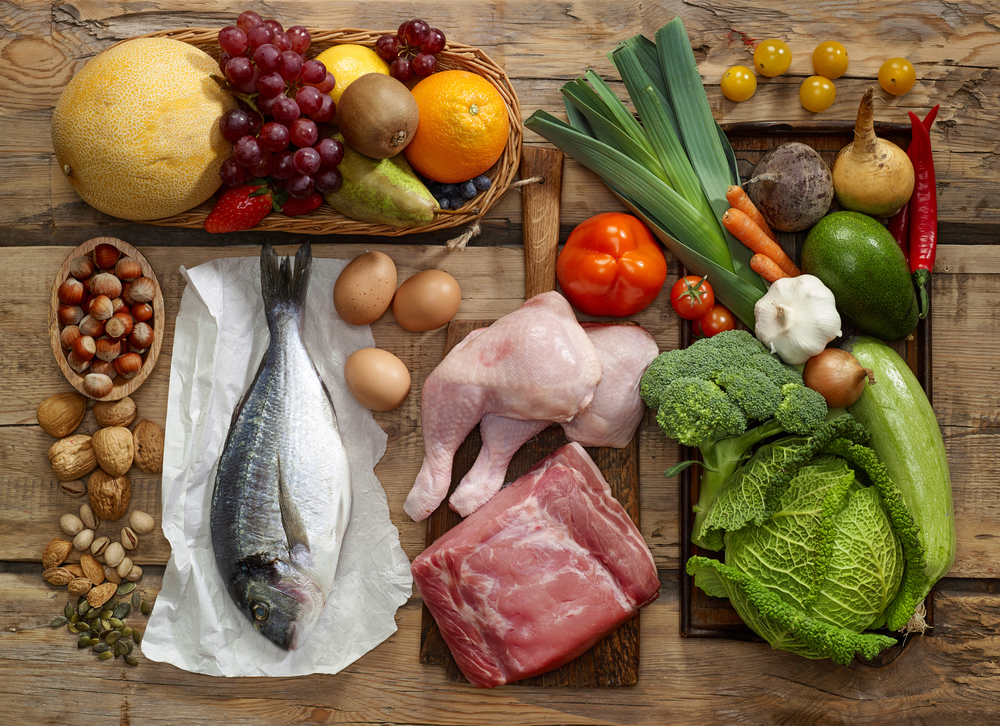Macronutrients are the three main nutrients your body derives from food. Your body needs each macronutrient in relatively large quantities to function properly (unlike micronutrients, which it needs in very small quantities).
So what are the three macronutrients?:
– Protein
– Carbohydrates
– Dietary Fat.
Protein is one of the basic components of food and makes all life possible. Amino acids are the building blocks of proteins and help provide for the transport of nutrients, oxygen, and waste throughout the body. Basically, they provide the structure for all tissue in our bodies. Protein contains 4 calories per gram.
Carbohydrates are the main source of energy for our body and muscles. Unlike fat and protein carbs are not essential meaning you could survive without them. However, as you will see that not ideal and carbs are an important part of any healthy diet.
They help regulate protein and fat metabolism, and aid in the growth and repair of tissues. Like protein, all carbohydrates contain 4 calories per gram.
Dietary fats, on the other hand, are essential for hormone production, brain function, and other body processes and you cannot live without them. There are potentially hundreds of different fatty acids, but just a few dozen are commonly found in the foods we eat.
Nutritionists commonly classify dietary fat as either saturated, unsaturated, or trans fats all of which I will explain in more detail later.
Now that you have a broad overview of the three macronutrients, let’s look at each individually starting with protein.
Protein Explained
If you follow any fitness blog or listen to any personal trainer they will all agree on one thing. Protein is important. Not only is it important for building and repairing muscle fibers after exercise, but it actually has thousands of other essential roles in the body, including:
– Strengthening the immune system through antibodies
– Hormone production
– Absorption and digestion of food
– Building and repairing body tissue, including muscles, tendons, ligaments, organs, bones, hair and skin
For body composition purposes, protein is actually the most important of the three macronutrients. The reason for this is that muscle is literally made out of it. If your muscle is the car, then protein is the metal out of which the parts are built.
Protein not only provides the building blocks for muscle growth, it also supplies the amino acids needed to reduce muscle breakdown. In essence, protein supports the creating of new muscle and helps maintain existing muscle; both functions are essential in maximizing muscle and minimizing fat.
Let’s look at what happens when you consume protein.
About 90% of the protein you eat is broken down into amino acids, which the body will use when it needs to build or repair muscle- or other tissues.
Unlike carbohydrates and fat, which the body can store for later use, amino acids have no form of storage in the body, so it’s important to ensure a consistent supply of protein throughout the day.
Amino Acids
But wait. Before we continue let’s clarify one thing. What are Amino Acids anyway?
Amino Acids are the building blocks of protein and are necessary to support muscle growth. Amino Acids are usually categorized as essential and nonessential.
There are nine essential amino acids, but you don’t really have to worry about them too much. Just understand that your body cannot create them and they must be obtained from foods and/or supplementation. On the other side, a non-essential amino acid can be produced in the body by re-configuring other amino acids.
Here is a list of essential amino acids:
– Isoleucine (BCAA)
– Histidine
– Leucine (BCAA)
– Methionine
– Lysine
– Phenylalanine
– Tryptophan
– Threonine
– Valine (BCAA)
And those are the non-essential amino acids, which your body can derive from other chemicals that are present in the body:
– Alanine (from pyruvic acid)
– Arginine (from glutamic acid)
– Asparagine (from aspartic acid)
– Aspartic Acid (from oxaloacetic acid)
– Cysteine
– Glutamic Acid (from oxoglutaric acid)
– Glutamine (from glutamic acid)
– Glycine (from serine and threonine)
– Proline (from glutamic acid)
– Serine (from glucose)
– Tyrosine (from phenylalanine)
Dietary Fat
Fats are an important part of your diet but often misunderstood, so let’s find out what fat is really all about and debunk a few myths along the way.
Besides protein and carbohydrates, Dietary fat is one of the three main macronutrients and besides protein one of the essential macronutrients. That means your body needs some fatty acids to survive and cannot produce them from other foods.
You need fat to regulate hormone production and to maintain healthy skin and hair. Fat also supports the absorption of vitamins A, D, E, and K, which is why they are called “fat-soluble vitamins”. And lastly, fat cells insulate your body and help to keep you warm.
One gram of fat has 9 calories, which is more than twice the number of calories in a gram of carbohydrates and protein, which each have 4 calories per gram.
Types Of Fats
There are two main types of fat. Saturated and unsaturated fats. Saturated fats are often referred to as bad fats that raise your LDL cholesterol level. Cholesterol is a soft, waxy substance that can cause clogged, or blocked, arteries.
Therefore, High LDL cholesterol can theoretically put you at risk for heart attack, stroke, and other major health problems. The debate is still unsettled whether Saturated fat directly increases your risk of heart problems, but until we know more it’s best to limit foods that are high in saturated fats.
Foods that contain a lot of saturated fats are animal products, such as butter, whole milk, cheese, ice cream, and fatty meats. Certain vegetable oils, such as coconut or palm kernel oil, also contain saturated fats. It’s easy to spot saturated fats as they are usually solid at room temperature.
Unsaturated fats, on the other hand, can help lower your LDL cholesterol. Most vegetable oils that are liquid at room temperature have unsaturated fats. Among the unsaturated fats we can distinguish two kinds:
Among the unsaturated fats, we can distinguish two kinds: Mono-unsaturated fats, which include olive and canola oil and polyunsaturated fats, which are found in sunflower-, corn-, and soy oil
One last type of fat that you will stumble across are trans fats. Trans fatty acids form when vegetable oil is infused with hydrogen.
This is often done to keep foods fresh for a long time. The problem is that studies show that relatively small amounts of these fats will increase the risk of different health problems, including heart disease, Alzheimer’s, breast cancer, depression, and more.
Therefore, try to avoid foods made with hydrogenated oils.
Carbohydrates Explained
Carbohydrates are the last of the three main macronutrients. Just as with fat and protein, there are a lot of debates around carbs. Before we get into these, let’s first find out what carbohydrates actually are.
Carbohydrates are derived from foods like fruits, vegetables, grains, potatoes, pastries, or candy and are considered the bodies favorite energy source.
From a chemical standpoint, carbs are sugar molecules that are a union of carbon, hydrogen, and oxygen (CHO). This means carbs are nothing more than one, or multiple sugar molecules that are linked and can be broken down by our body for energy.
When you consume high carb foods your body breaks them down into the simple sugar glucose, which is then transported throughout the body to provide energy, fuel important reactions, and maintain blood sugar levels.
Any glucose not used is stored in your liver and muscles as glycogen, or if the stores are full, as fat.
During high-intensity activities (such as weight training or sprinting), your body uses glycogen and converts it back to glucose for new fuel. If glycogen levels are low, hard workouts become increasingly difficult to complete, and your performance will suffer. Next to its importance for workout carbohydrates have other benefits.
They include:
– Supplying the Nervous System with its Fuel
– Refueling Glycogen Stores
– Secreting Insulin
Types Of Carbs
If you’ve done some research on carbs you have probably come across some of the following classifications:
healthy vs. unhealthy carbs
good vs. bad carbs
simple vs. complex carbs
If you look at all these categories it’s easy to get confused!
A simple way of thinking about carbs is remembering that they are always sugar molecules, which are broken down by our body into glucose. Glucose is a single sugar molecule that is used as energy by the body’s cells.
There are three different types of carbohydrates:
1) Monosaccharide – one sugar molecule (e.g. glucose or fructose in fruit)
2) Disaccharide – two sugar molecules (e.g. sucrose in table sugar or lactose in milk)
3) Polysaccharide – multiple sugar molecules, (e.g. pasta, potatoes or rice)
When a carbohydrate is “simple” it’s either a mono- or disaccharide, both of which are easily broken down and quickly absorbed into the bloodstream.
“Complex carbs”, on the other hand, are polysaccharides. Your body takes longer to break down their more complex molecular structure, which is also why they promote satiety better than simple carbs.



